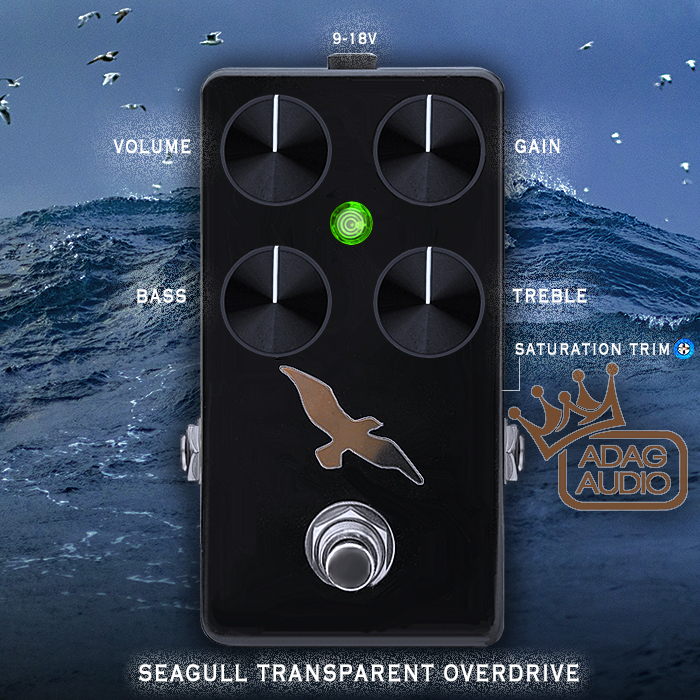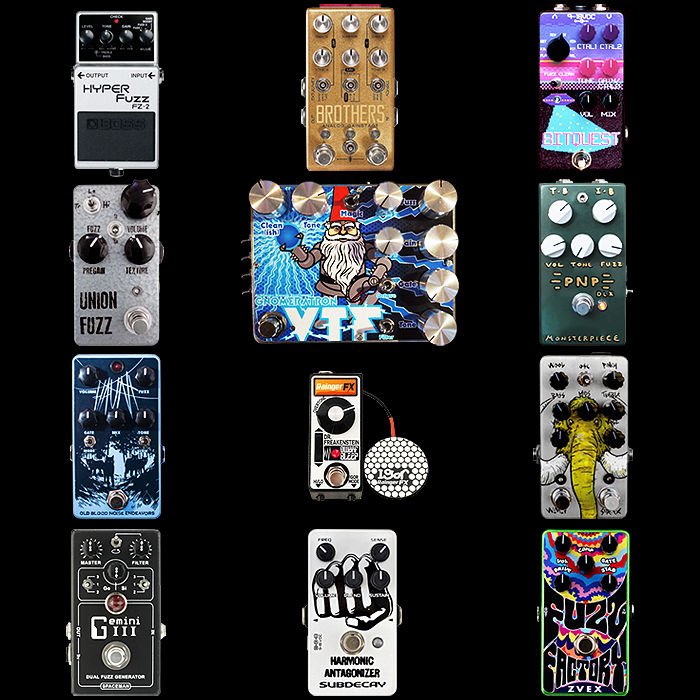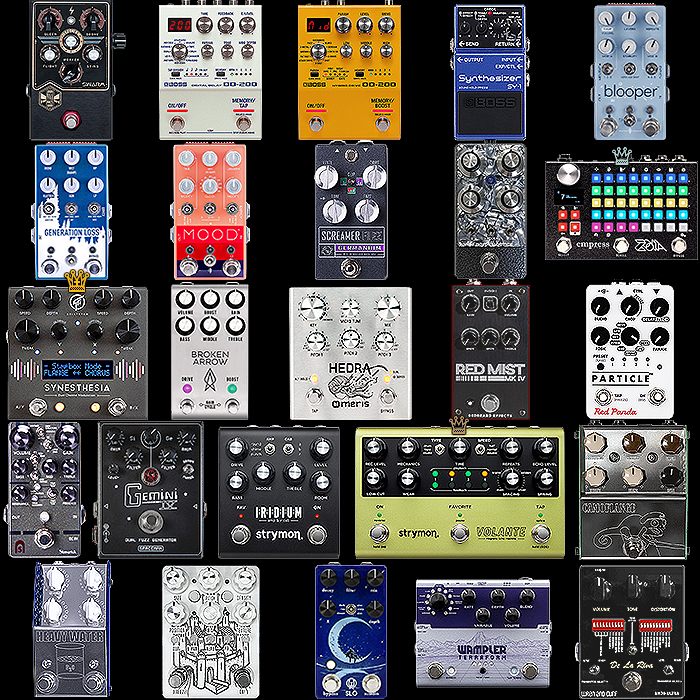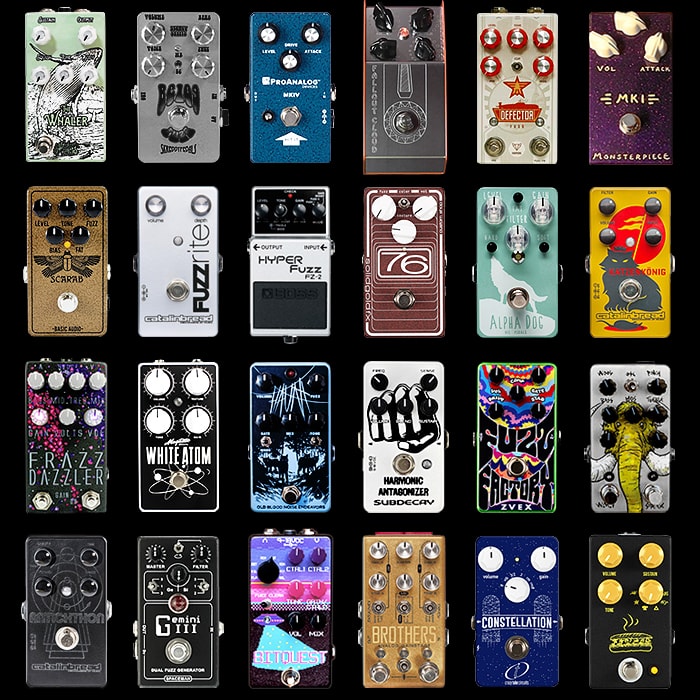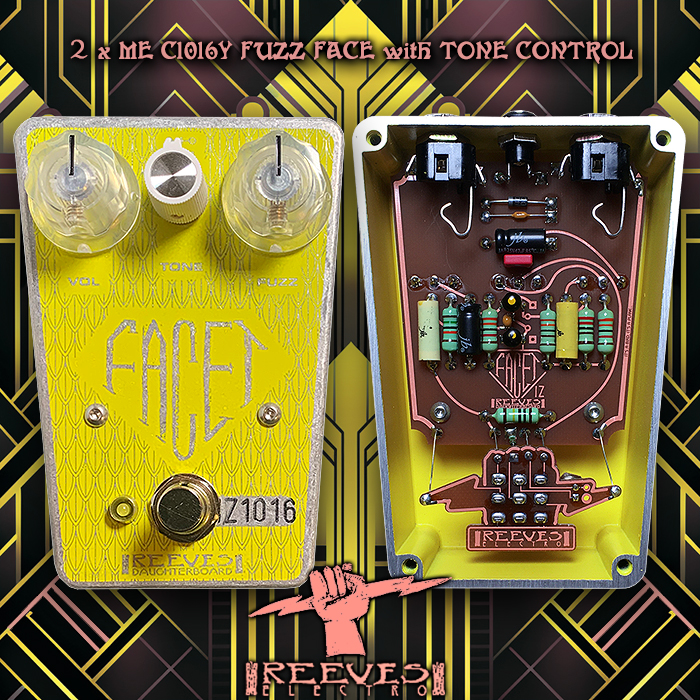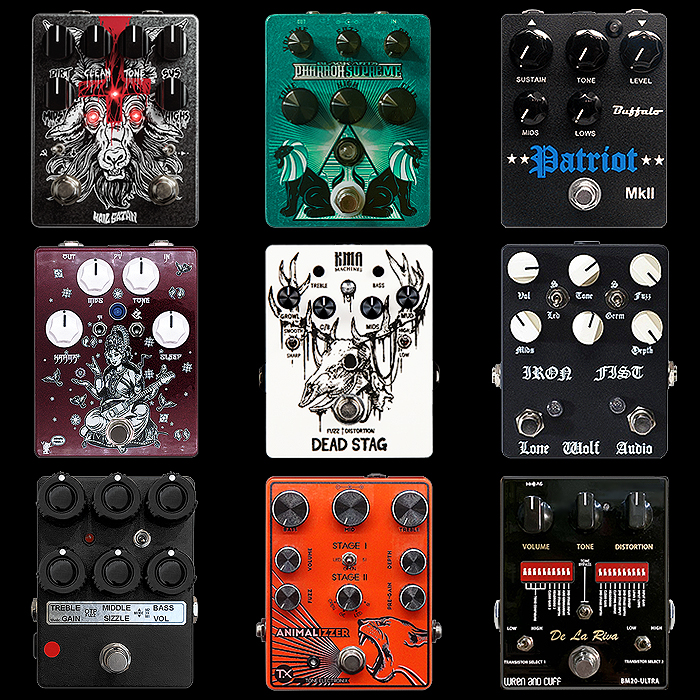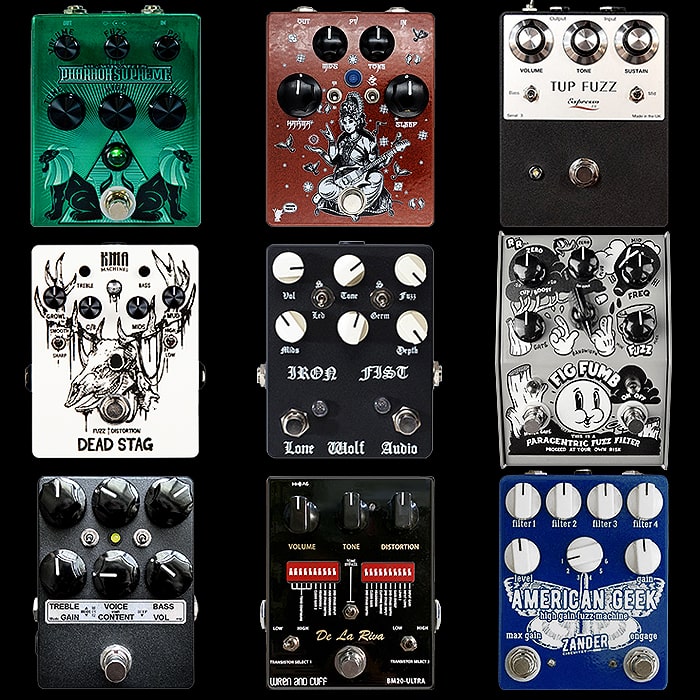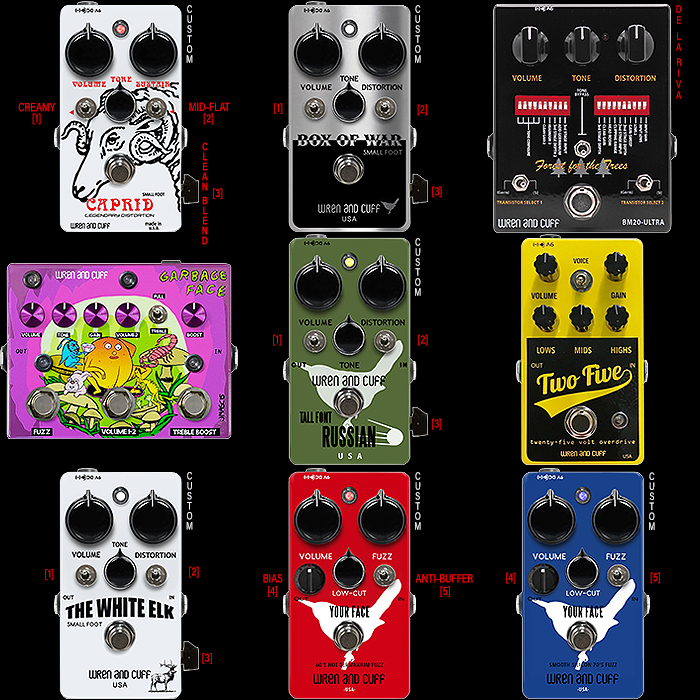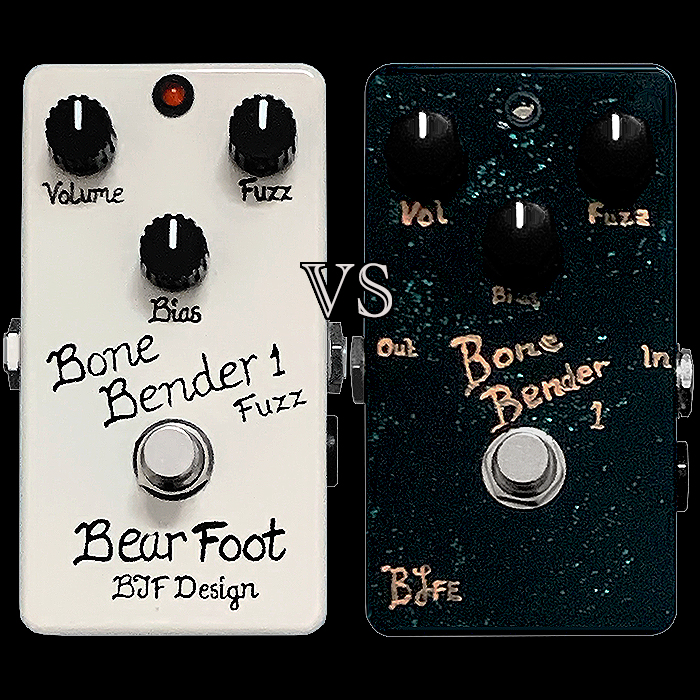4 Fantastic Germanium and Silicon Switching Fuzz Pedals
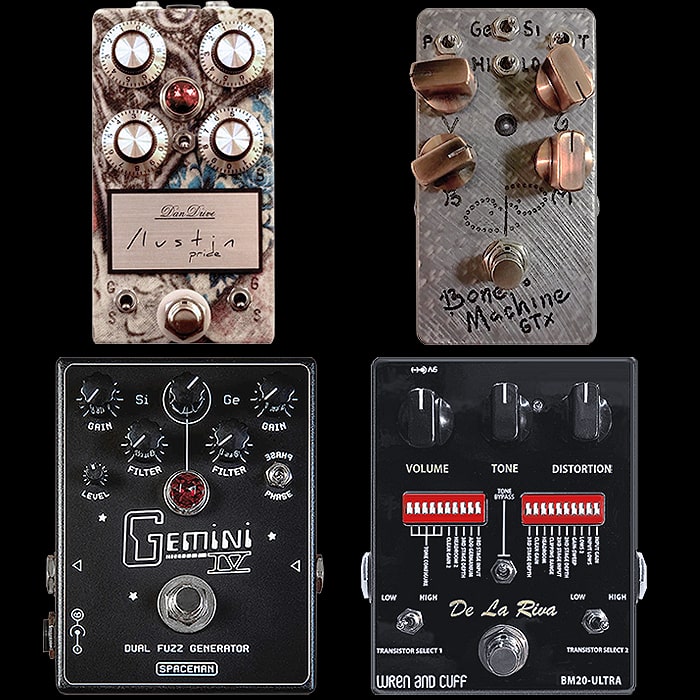
This article is somewhat in response to the fairly recent arrival of my long quested for Spaceman Gemini IV (originally chasing the III), and the imminent arrival of my DanDrive Austin Pride Fuzz. In fact when I was working on my last but one article on Tone Benders I was in two minds as to whether to include Paul Trombetta’s Bone Machine GTX - as I’m not 100% clear on what its circuit provenance is and exactly which fuzz family it is supposed to belong to - in the end I determined to do a separate article where I might cover all these fantastic pedals which allow you to switch between Germanium and Silicon Transistors. The 4th pedal included here is the excellent Wren and Cuff De La Riva BM20-Ultra which I also included in my piece on Versatile Multi-Voice Big Muffs!
DanDrive Austin Pride Fuzz (César Díaz Texas Square Face Fuzz) (2 x NTE103 + 2 x NTE123 or NTE128) - €349 (including Deluxe cloth wrap)
This significant evolution and enhancement of the 1991 Texas Square Face Fuzz carries rarified pairs of both Germanium NTE103 and Silicon NTE123 or NTE128 Transistors - where you can deploy 2 of the same of each kind or combine in hybrid fashion. Moreover the Austin Pride has 4 knobs versus the original's 2 - so Level | Fuzz | Clean-Up | Bias, and an additional 2-way Bass boost toggle switch and a built-in Diaz Volume Mod which gives you 20% more range on the Level dial. So if you were wondering whether you would be better off with a Germanium or Silicon Fuzz Face variant - why not just go for both in this one box! As usual we have Dan's superb attention to detail here, and although the pedal is available in a more muted relic'd matt black anodised enclosure - I much prefer the Renaissance flair of the Deluxe cloth-wrapped edition as pictured. César Díaz engineered the Texas Square Face for Stevie Ray Vaughn as his stock Fuzz Faces kept breaking down. Dan has taken all of that way beyond the next level with all those extra tone-shaping elements and Transistor selection. This is the next level Fuzz Face you know you were looking for!
Paul Trombetta Bone Machine GTX (2N404 + 2N5088 + Gooped?) - c£500 (rare)
As I've mentioned previously - I'm not entirely sure what this circuit is based on at its core - in fact it might be very much Paul's own thing - as in any case the circuit is mostly gooped and I can only discern the two Transistors referenced in the above title - there's a lot more to this circuit though. And if it does indeed just have one transistor of each type then there is some serious magic going on with the circuit to make it as rich sounding as it is. The real forte of the Bone Machine though is just how versatile it is, and how many different voicings it harnesses with those 4 dials and 4 switches - from sparkly spangly cleans, smooth overdrive and on to various Fuzz tones, horn sounds, ring modulation, upper and lower octaves and a feedback-locked secret synth mode. I can get all manner of tones out of this including several kinds of Fuzz Face and Tone Bender varieties. The 4 knobs are Volume | Gain | Bore (Thickness) | Mood (Bias). The Mood knob takes you from overdrive to distortion, onto fuzz and greasy spit, then octaves on wound strings and trumpet, french horn and trombone splat - while the Bore dial ranges from Fat to Skinny and controls the fatness / richness of the whole circuit. For the 'Bone' sounds, low octaves and ring mode effects - the Bore needs to be cranked to 5 o'c. There are 4 toggle-switches, a 3-way Presence - Normal/Bright/Dark switch, then Ge/Si Transistor selector switch, T Input Cap switch for stock or 'Thin' input Cap which significantly alters the core tonality. Then you have the Hi/Lo Mood Range (Bias) switch - where for Horn, Octave and 'Bone' sounds you need to set Transistor to Silicon, Mode Range to Lo, Bore to Max and Mood to 12 o'c. As I keep saying - just an all-round fantastic Tone Bone Machine!
Spaceman Effects Gemini IV Dual Fuzz Generator (AC125 + AC176 + 2N2222 + 2N3700 + 4 x 2N5088?(Gooped)) - from $299-$449
Readers of this blog will know that I've been chasing a reasonably priced Gemini III in Europe for years now. The ones that were appearing on Reverb.com were all based in the USA and at around £1,000 just did not make practical sense - especially not when you factor in delivery and customs charges to the UK. So I was delighted and relieved when Zak Martin released a new and improved version of the circuit a couple or so weeks ago - mine arrived with me last week. The circuit has been enhanced with independent dials per Transistor Type for Gain and Filter, as well as a new cool Phase toggle-switch. From what I know of the original, the Transistors are roughly the same - not exactly, but close enough, while owners of both pedals say that the Gemini III sounds both slightly warmer and more gritty, while generally there is a lot more range of tones - gain etc. in the newer GIV version. I've not had it quite long enough to sing its praises fully sufficiently, but so far so good - it seems to be definitely living up to expectations. This circuit is obviously unique in allowing you to blend the two different transistor types in parallel - not sure why more makers haven't done similar - I feel that's the wave of the future in any case - blending together two complementary circuits in parallel - expect to see a lot more overdrives, fuzzes and distortions of that nature in the near future. I'm quite intrigued by the selection of Transistors used in this case, and the 4 that have been gooped to preserve their identity. If a maker goops his product I have no inkling to share those secrets - that is their own choice of modus operandi and they should be entitled to protect their intellectual property to a certain degree.
Wren and Cuff De La Riva BM029 Ultra (2 x 106NU70 + 2 x MPSA18) - $299/£299

The De La Riva is one of the most impressive fuzz confections of recent years, and even though billed as 'a true muff lover's dream' - circuit-wise it also owes quite a lot to the Fuzz Face, as we have two pairs of Transistors here rather than the banks of 4 more commonly associated with Big Muffs. The pedal has just 3 knobs - Volume | Tone | Distortion, with further toggle-switches for Tone Bypass and 2 x Transistor Selector switches with Left being Germanium and Right being Silicon - so you can have both the same or one of each. The really clever thing though is that the circuit is split into 20 sections controlled by 20-handy surface-mounted dip-switches which allow you to switch in or out each section independently - obviously with a number of those being highly interactive. There are in effect 4 cascading gain stages here with various options to activate different gain and tone components throughout the circuit - with the only confusing thing for me really being the 5 Tone Switches on the far left. The Circuit actually starts on the far right - with 'Input Gain' being the first component, and the 5 Tone Switches which must equate to individual caps are at the other end of the circuit - which seem to boost/cut different frequencies, but it's unfortunately not as straight forward as Lows, Low Mids, Mids, High Mids, Highs - rather it's the kind of pedal that you just need to at persevere at/with flicking switches up and down and then making notes where you get your desired sweet spots. This is the kind of pedal that is screaming out for a digital control layer with presets - I also feel that this particular control topology might not be the most practically usable. Far better to have one or two rotary dials which have sweet spots largely dialled-in already which you can then fine-tune with a couple of tone-shaping controls. This pedal is a great achievement though and it teaches you a lot about how fuzz circuits work - but you can easily get lost for half a day or a day at a time just playing around with switches and trying to find some more sweet spots - so it's a genius idea but not the most user-friendly execution necessarily - I still really like it though and I have had a lot of fun with it of late making is sound like a creamy rich Fuzz Face which is something it does with some aplomb!
Final Thoughts
I have all of these already in my Tone Library - well the DanDrive Austin Pride should be here sometime in August as it was ordered at the start of June, and there is a 12 week production schedule if you want one of Dan's pedals. And while superficially a lot of these purport to do the same sort of thing - with both really smart switching options but also enhanced tone-shaping abilities. Nevertheless each of these sounds and feels wholly distinct - so you never feel that you need not have bought that variety.
I always view Fuzz pedals as having a Soul (Core Tone) and Character (Harmonic Texture) - and each of these is quite distinct with a unique set of abilities. It would be a very difficult task to separate any of these out on the basis of you could only have one. If you had to remove one from contention though then alas that would be the De La Riva - as however fantastic it is, it is just a little too fiddly for its own good, and the process of dialling/switching in a key sound can be just a little too frustrating. You also have the usability issue of small-print legends and small switches - so even if/when you think you know what you're doing it's all to easy to hit the wrong switch and not spot it.
As of the moment the Gemini IV is leading rotational duties on pedal-chain slot #5, the Bone Machine GTX has been in and out of that slot a tonne of times, while I deploy the De La Riva typically on slot #20 as now that mainly Silicon Fuzz slot has become. When the DanDrive Austin Pride arrives - that will get a decent innings on Slot #5 too, it will be interesting to see which pedal gets to see the most action on that slot a few months from now - possibly I just need to keep rotating them quite regularly - say every couple of weeks or so!
Price-wise these are all upper-echelon really - with both the De La Riva and Gemini IV at around $300/£300, then comes the Austin Pride at €349 in that particular specification, while I've not seen any Bone Machine GTX's made my Paul Trombetta for at least a good couple of years now (mine is from 2016), and Mint second hand prices are somewhere between £500 & £600 equivalent if you can get hold of one. I was very lucky to track down one in Italy back in January - courtesy of Reverb.com. These don't tend to come up for sale very often at all as their owners tend to like to keep hold of them - as long as they're being played I'm cool with that. I'm always saddened and frustrated by just how many of these incredible Tone Machines end up as shelf-ware for opportunistic flippers and schemers - much as like what ruined Record Store Day for me. These are musical devices after all - instruments in their own right, and should be reserved for active players!









